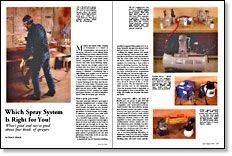Which Spray System Is Right for You?
What's good and not so good about four kinds of sprayers
Synopsis: Finishing chemist Chris A. Minick explains how a spray gun works and how gun composition affects the kind of finishes you can spray. There are internal and external mix high-pressure guns, and high-pressure, low-volume guns. There are airless spray systems, too, and Minick explains how you make a choice among the options. He offers side information on evaluating spray patterns.
Mention the names Delta, General or Powermatic to a bunch of cabinetmakers, and everyone in the group will know you’re talking about woodworking machinery. Mention DeVilbiss, Mattson or Sharpe to the same crowd, and you’ll likely get some blank stares. Those companies are just three out of dozens that make spray-finishing equipment. Chances are, though, many woodworkers just don’t know as much about choosing a spray system as they do about buying a tablesaw. Considering that a high-quality spray system costs as much as a decent tablesaw ($700 or more), it pays to be well-informed before you buy.
Andy Charron explains why he switched to spray finishing in his shop (see the story on p. 56 in this issue). I’ll present some equipment options—high-pressure spray guns (see the photo at left), high-volume, low-pressure (HVLP) systems and airless spray guns. But first, it would be helpful to know a little about spray-gun anatomy.
How a spray gun works
The basic principle behind a spray gun is relatively straightforward. A stream of liquid finish is forced into an airstream, which breaks the liquid into tiny droplets (atomization) and carries them to the target surface. It sounds simple, but in reality, a collection of precision parts must work in concert to pull the whole thing off.
In a standard high-pressure system, air flows from the compressor hose through a series of valves and baffles in the body of the gun and out through an air cap. The valves and baffles control the maximum atomization pressure at the air cap. The volume of air used by the gun as well as the spray pattern is governed by the size and placement of the holes in the air cap.
A standard air cap for furniture finishing produce s a tapered (fan) patter n 9 t o 1 1 in. long. Typically , the gun uses about 8 cubic feet per minute (cfm) of air at 50 psi.
From Fine Woodworking #113
For the full article, download the PDF below:
Fine Woodworking Recommended Products

Dividers

Ridgid EB4424 Oscillating Spindle/Belt Sander

Odie's Oil





















Log in or create an account to post a comment.
Sign up Log in